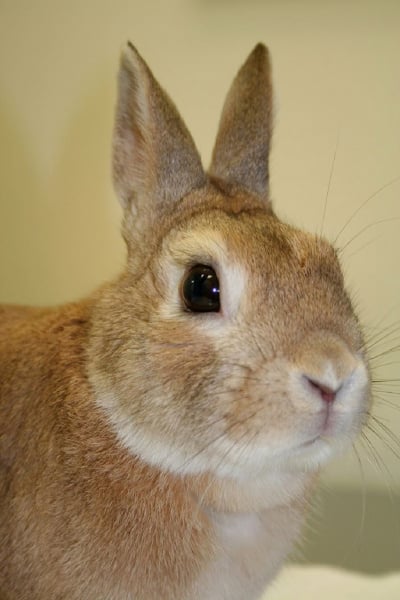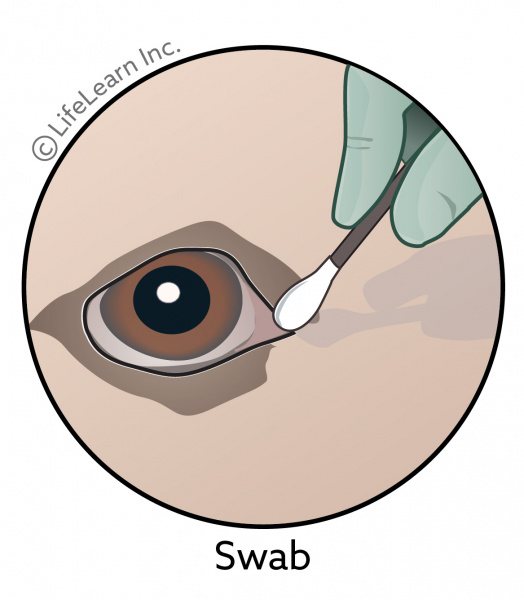Will a Mo.com.coma Rabbit Still Take Care of Babies if a Human Has Held Them?
There are four major infectious diseases seen in pet rabbits. Two serious diseases caused by viruses rarely seen in indoor pets, are myxomatosis and viral hemorrhagic disease. Considering they are viral diseases, there are no effective treatments once the rabbit is infected. Two other infectious diseases of rabbits are encephalitozoonosis (a neurologic disease acquired past the parasite Encephalitozoan cuniculi) and respiratory infection caused past the bacteria Pasteurella multocida. These are common in indoor pet rabbits.
Myxomatosis 
This disease is caused past the myxoma virus, which is widely distributed in the wild rabbit population. Even if your rabbit never comes into direct contact with animals from the wild, information technology can still become infected with this disease, because the virus is spread by bites from mosquitoes, flies, fur mites, and fleas. Information technology is also acquired from injuries caused by contaminated thorns or thistles, or past direct contact with an infected rabbit. It is found in North America (primarily California), Due south America, Europe, and Commonwealth of australia. Pet rabbits are more than susceptible and more than severely affected than wild rabbits, as wild rabbits have developed a meliorate genetic resistance. Clearly, outdoor rabbits are at greater risk of getting this illness.
The incubation catamenia is 1-three days, and the first signs are evolution of puffy eyelids, a purulent (pus- producing) conjunctivitis, and lethargy. Subcutaneous (under the skin) swelling extends effectually the eyes, ears, and genital region. Swelling can quickly progress to skin hemorrhages, trouble breathing, decreased to no appetite, fever, and development of generalized skin tumors. Death is normally within i-two weeks after infection, only occasionally animals survive, and signs will slowly regress over about 3 months. Rabbits showing signs of myxomatosis should be seen by a veterinarian equally soon as possible. Treatment involves supportive care with fluids, syringe feeding, anti-inflammatory drugs, and pain relievers.
"Myxomatosis virus is spread past bites from mosquitoes, flies, fur mites, and fleas."
Vaccination may provide temporary protection. This vaccine is not available in some countries. Significant animals should not be vaccinated, nor should rabbits less than six weeks old. Occasionally vaccinated rabbits have a local reaction at the injection site, just compared with the lethal infection, this reaction is insignificant.
Viral hemorrhagic disease
As well called rabbit calicivirus (RCV), rabbit hemorrhagic disease (RHD), and viral hemorrhagic disease (VHD), this highly contagious affliction was first recognized in China in 1984 but at present has an about worldwide distribution. Viral hemorrhagic disease is caused by a calicivirus and, although the incubation menstruum is upward to three days, animals may die suddenly without any clinical signs. The disease is transmitted by straight contact with infected rabbits, rabbit products, rodents, and contaminated cages, dishes, and clothing. The virus can likewise transmit over short distances in moist air. Rabbits in close proximity to other rabbits (such every bit at breeders and rabbit shows) are at a greater risk. Rabbits that recover can get carriers of the virus and may shed virus upwardly to 4 weeks.
If there are signs of infection, they include decreased to no appetite, fever, sluggishness, and plummet. In that location may be convulsions and coma, difficulty animate, foaming at the mouth, or bloody nasal belch. Some animals survive this acute phase simply dice a few weeks later on from liver failure.
"Animals with this highly contagious disease may die suddenly without whatsoever clinical signs."
Given the horrendous death experienced past afflicted rabbits, pet rabbits in areas where this illness is rampant should exist vaccinated annually (or fifty-fifty as often every bit every 6 months). Vaccines are not available in every country; they volition not eradicate the disease simply may reduce the number of deaths. Speak to your veterinarian nearly vaccine availability in your area and the risks and benefits of its use. New rabbits should be isolated from other rabbits for thirty days to minimize the risk of this infection.
Encephalitozoonosis (Encephalitozoon cuniculi infection)
Encephalitozoon cuniculi is a microscopic parasitic organism that has to live inside a cell to survive. It tin can bear upon rabbits, mice, hamsters, dogs, cats, guinea pigs, and humans. It is spread in rabbits from mother to offspring in the uterus and from rabbit to rabbit through infected urine.
It ordinarily causes a latent status in rabbits, and then that many infected rabbits show no signs. When signs develop, the affected rabbit may develop dense white cataracts in ane or both eyes, a head tilt, or more severe signs, such every bit twitching eyes (nystagmus), lack of appetite, difficulty walking, uncontrollable rolling over in i direction, tremors, and seizures.
Treatment involves administration of anti-inflammatory and anti-parasitic drugs for several weeks, along with supportive intendance such as syringe feeding and move sickness medication. There are currently no medications that are guaranteed to clear the infection, and many rabbits continue to testify signs even later treatment.
"Rabbits with encephalitozoonosis may develop dense white cataracts in ane or both eyes, a caput tilt, or more severe signs, such as twitching optics (nystagmus), lack of appetite, difficulty walking, uncontrollable rolling over in one direction, tremors, and seizures."
Encephalitozoonosis has been described in a few cases in people, but its significance is poorly understood. Very young, elderly, and immunocompromised people are most at chance. Individuals with poorly functioning immune systems likely should non be effectually infected rabbits.
Pasteurellosis (Pasteurella multocida infection) 
Pasteurella multocida is bacteria that unremarkably causes abscesses, respiratory infections, and chronic inflammatory disease in rabbits. It can infect the nasolacrimal (tear) ducts, eyes, ears, and nose, and can cause abscesses of tooth roots, basic (particularly the jaw), skin, tissues under the skin, and internal organs. This organism ordinarily causes an upper respiratory tract infection often called snuffles which frequently occurs in young rabbits.
Many cases of snuffles are mild, involving slight ocular or nasal discharge and sneezing and, if defenseless early, can be effectively treated or managed. If left untreated, this infection tin progress to become severe, chronic, and potentially fatal. A swab for bacterial culture and antibiotic sensitivity testing tin can exist taken of ocular or nasal discharge to assistance guide handling. Treatment commonly involves either oral or injectable antibiotics, given for a minimum of 2-4 weeks. In some cases, treatment can be required for months depending on the response to therapy.
Certain oral antibiotics, especially oral penicillin and similar drugs, tin be fatal to rabbits. These antibiotics upset the normal gastrointestinal bacteria, leading to overgrowth of toxin-producing bacteria, diarrhea, dehydration, and death and should never be used in rabbits. In that location are condom oral and injectable antibiotics prescribed by veterinarians to treat this infection in rabbits, just none is leads to a definitive cure. Heart drops and nose drops, every bit well as oral anti-inflammatory drugs, may be used in conjunction with other antibiotics, as prescribed your veterinary.
"Pasteurella multocida can infect the tear ducts, eyes, ears, and nose, and can cause abscesses of tooth roots, basic, skin, tissues under the pare, and internal organs."
Rabbits with abscesses in or under the skin, in the jaw, or in an internal organ oftentimes crave surgery to remove the abscess. Abscesses in the middle ear (causing balance bug), eyeball (causing incomprehension) or in basic or major organs or often difficult to care for and may recur, even with surgery.
All rabbits carry Pasteurella organisms, but merely some rabbits will manifest disease (their immune systems by and large go on the organisms in check). Stresses such every bit poor nutrition, change in nutrition, introduction of a new pet or person in the business firm, overcrowding, environmental stresses, immunosuppression, or the presence of other disease, may trigger clinical signs. Many rabbits are chronically infected. The affliction is easily transmitted betwixt rabbits through direct contact with infected rabbits' nasal or ocular discharge, contact with pus from an abscess, or contaminated items such every bit bedding and food and water bowls. New rabbits should be isolated (for almost i month) earlier being introduced to existing pets. Fifty-fifty with successful medical or surgical handling, relapses may occur if your rabbit is exposed to stressful situations. Be sure to have your rabbit checked annually by a veterinarian to go on him equally healthy equally possible to minimize problems with pasteurellosis.
Source: https://vcahospitals.com/know-your-pet/rabbits-diseases
0 Response to "Will a Mo.com.coma Rabbit Still Take Care of Babies if a Human Has Held Them?"
Post a Comment